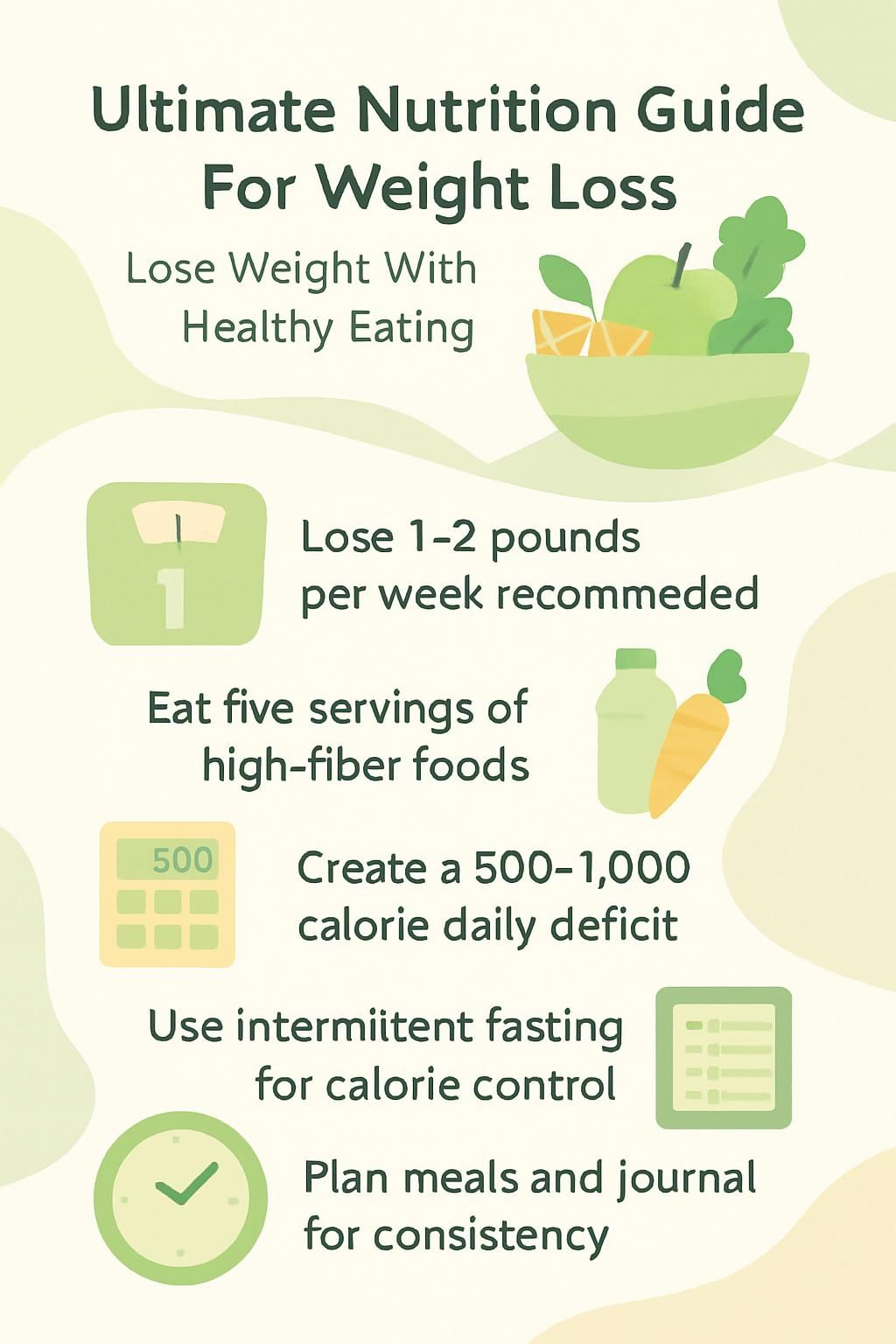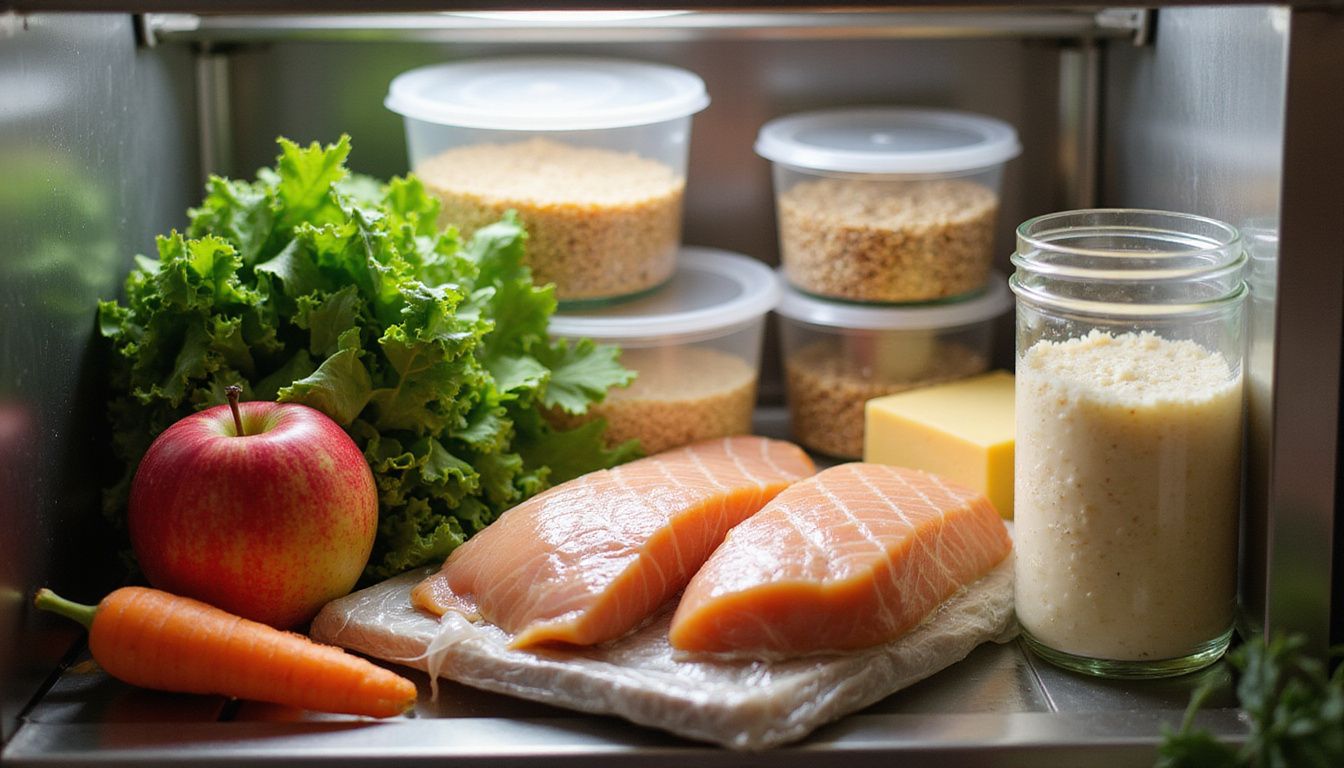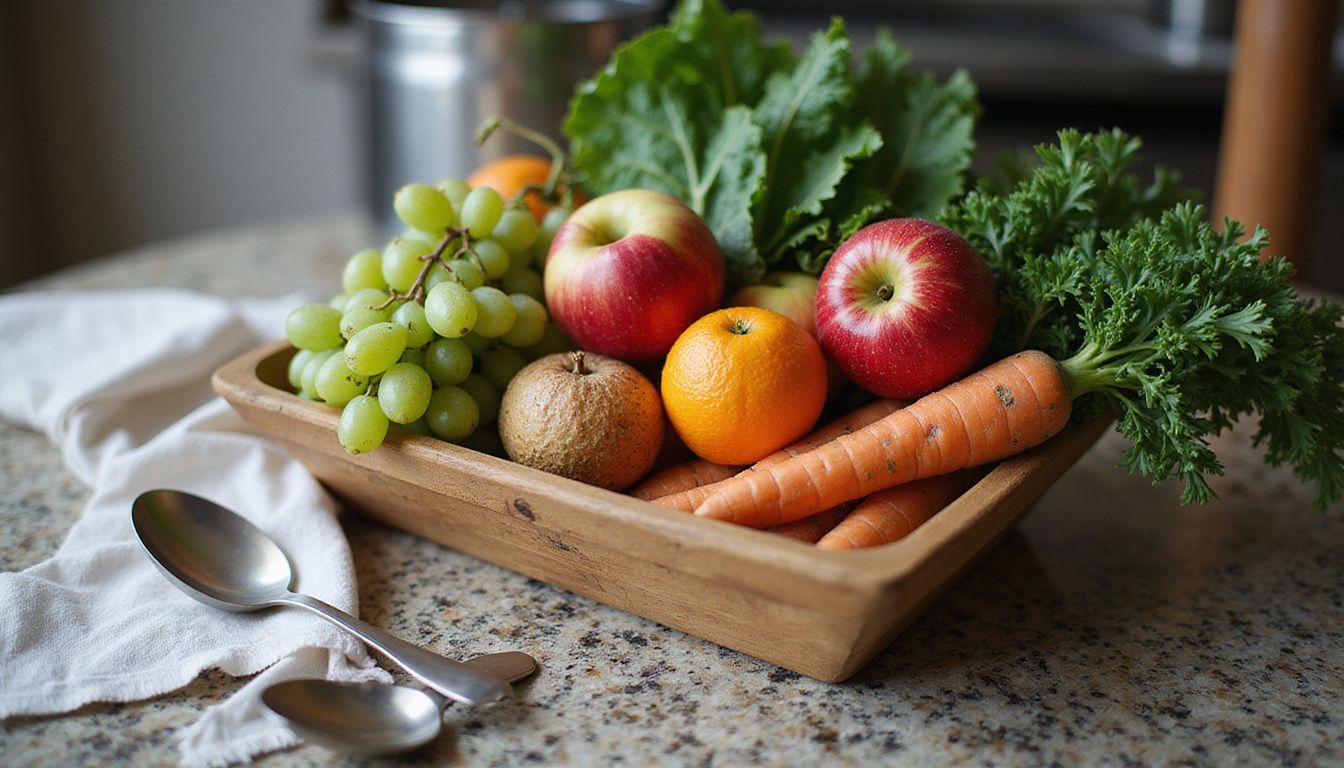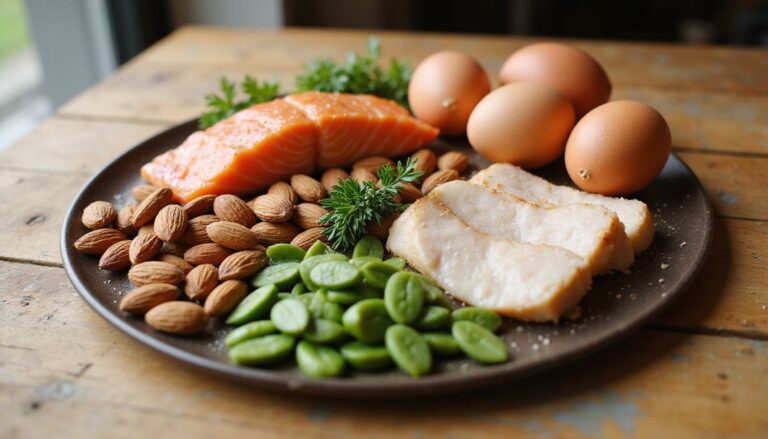Ultimate Nutrition Guide For Weight Loss: Lose Weight With Healthy Eating
Our Nutrition Assistant AI Suite will transform your body. You will lose fat, get toned, and build muscle. Gain confidence and optimal health.
You want to lose weight, but the advice online often conflicts. Healthy eating helps you cut calories, feel energetic, and lower your risk of type 2 diabetes, heart disease, and high blood pressure.
This Nutrition Guide For Weight Loss turns science into doable steps. You will learn simple food swaps, smart portions, and meal plans that fit real life. Use these ideas to start losing weight and keep it off.
Key Takeaways
- Balanced diets like Mayo Clinic, DASH, or Mediterranean, built on fruits, vegetables, whole grains, and lean proteins, support losing 1 to 2 pounds per week and reduce risks of type 2 diabetes, heart disease, and hypertension (CDC, 2020 to 2025 Dietary Guidelines).
- High fiber foods, at least five servings daily, plus low fat dairy and plant proteins increase fullness and improve weight results. Limit red meat, ultra processed foods, sugary drinks, and refined carbs.
- Creating a calorie deficit of 500 to 1,000 calories per day with portion control and mindful eating is the core strategy for steady fat loss and long term maintenance.
- Intermittent fasting methods, such as a 16 hour daily fast or the 5:2 plan, can help control calorie intake and improve insulin response. Early research suggests added benefits with few serious risks.
- Meal planning, food journaling, and consistent meal timing, paired with regular exercise, improve adherence, cut cravings, and raise your chance of success.

Understanding Healthy Eating for Weight Loss

Healthy eating supports weight loss by meeting your nutrition needs while lowering energy intake. With a few steady habits, you can manage portions, choose better foods, and see progress.
Why is balanced nutrition important for weight loss?
Balanced nutrition gives your body energy, vitamins, and minerals while you cut calories. Eating across food groups, like fruits, vegetables, whole grains, beans, fish, lean meat, and healthy fats, lowers the risk of obesity related diseases such as type 2 diabetes and cardiovascular disease.
Research shows that nutrient rich, lower calorie meals help many people lose 1 to 2 pounds per week while preserving muscle. The Mayo Clinic Diet focuses on long term weight skills, including smarter choices and daily habits. High fiber foods, like beans and whole grains, help you feel full compared with refined carbs.
During college, tracking protein, fiber, and total calories helped me more than cutting calories alone.
A balanced diet is not just about losing weight; it’s about staying healthy for life.
Knowing how a calorie deficit works makes day to day food decisions much easier.
How does a calorie deficit help you lose weight?
Weight loss happens when you eat fewer calories than your body burns. Your body uses food for fuel. Extra calories are stored as fat and can raise your body mass index.
A low calorie diet of about 1,000 to 1,500 calories can create a daily deficit of 500 to 1,000 calories for many adults. This shortfall pushes your body to use stored fat for energy.
Health experts often suggest a 500 to 1,000 calorie deficit per day, which can lead to 1 to 2 pounds lost each week. The Mayo Clinic Diet starts with two weeks of tighter choices to lower calorie intake. Many people see 6 to 10 pounds lost in that early phase. A consistent eating plan centered on healthy foods helps you sustain these results.
Key Nutritional Strategies for Weight Loss
Smart diet strategies help you manage calories, increase nutrients, and build habits that last. A clear plan keeps your effort focused and steady.
Why choose whole, minimally processed foods?
Whole, minimally processed foods, such as fruits, vegetables, and whole grains, deliver fiber and volume for fewer calories. Fiber increases fullness and supports weight control. It also lowers the risk of diabetes and heart disease.
The Mayo Clinic Healthy Weight Pyramid highlights larger portions from the base, like fruits and vegetables, for better appetite control. The New Nordic diet, with whole grains and plant foods, shows weight and health gains in studies.
Switching from packaged snacks to simple whole foods often boosts energy and cuts cravings. In my last weight loss program, that single change made afternoons much easier.
Higher fiber intake can also help lower the risk of hypertension, type 2 diabetes, and heart disease. Next, learn how to build more nutrient dense meals.
How to prioritize nutrient-dense meals?
After choosing mostly whole foods, build meals around produce, lean protein, and healthy fats. Fill half your plate with fruits and vegetables. Add protein like beans, grilled fish, or skinless poultry.
The Mediterranean diet models this approach. It limits red meat, features fish and legumes, and includes dairy products such as yogurt and cheese.
Aim for at least five servings of high fiber foods per day. This supports fullness and helps you stay within your calorie target. Include nuts or seeds for healthy fats, for example in salads or oatmeal. Swap white rice for brown rice or regular pasta for whole wheat to increase fiber.
The Portfolio diet showed that eating more plant sterols, soy protein, soluble fibers from oats and barley, and nuts lowers LDL cholesterol while promoting modest weight loss.
Plan your meals. The Mayo Clinic Diet suggests filling half your plate with vegetables at lunch and dinner. That simple rule keeps calories in check while still allowing satisfying portions.
What are effective portion control and mindful eating tips?
Portion control and mindful eating help you cut calories without feeling deprived. Use these practical steps.
- Use smaller plates and bowls to reduce portions at each meal.
- Eat slowly and chew well so fullness signals can catch up.
- Pause midway through meals to assess if you feel satisfied.
- Avoid screens during meals. Focus on taste, texture, and satisfaction.
- Choose low calorie snacks like fruit, vegetables, or a small handful of nuts.
- Serve food in the kitchen, not at the table, to limit second helpings.
- Build plates with lean protein, whole grains, low fat dairy, and vegetables.
- Drink water before and during meals to help reduce snacking.
- Track your intake with a food journal or app to spot patterns.
- Use non food coping tools for stress, like a short walk or reading.
Next, see which high fiber foods best support your plan.
Foods to Include in a Weight Loss Plan
Picking the right foods can make weight loss easier and improve health. Evidence from large reviews shows that certain foods support fullness and steady blood sugar.
What are the best high-fiber fruits, vegetables, and whole grains?
High fiber fruits, vegetables, and whole grains keep you full and support long term weight control. Aim for at least five servings of fiber rich foods each day.
- Apples, pears, and berries provide 3 to 5 grams of fiber per serving. They help with energy balance.
- Bananas add fiber and potassium, which supports healthy blood pressure and exercise.
- Carrots, broccoli, and leafy greens such as spinach or kale deliver fiber and key micronutrients.
- Sweet potatoes supply complex carbs and vitamin A for immune support.
- Oats, brown rice, and quinoa rank high in fiber and steady blood sugar.
- Whole wheat bread and pasta beat refined versions for digestion and fullness.
- Barley, bulgur, and farro bring variety and extra fiber to your meals.
- Beans, lentils, and chickpeas offer fiber, protein, and slow digesting carbs.
- Strawberries, raspberries, and blackberries provide 6 to 8 grams of fiber per cup with natural sweetness.
- The DASH and New Nordic diets both center on vegetables, whole grains, and fiber for weight control.
Next, choose lean proteins that fit your goals.
Which lean protein sources support weight loss?
Protein helps you feel full, protects muscle, and supports a healthy metabolism during weight loss. Choose a mix of the options below.
- Pick chicken, turkey, or fish instead of fatty meats like bacon or sausage.
- Choose lean red meat cuts, such as sirloin or tenderloin, and limit processed meats.
- Include seafood like salmon and tilapia for protein and omega 3 fats.
- Use low fat dairy such as skim milk and Greek yogurt for protein with fewer calories.
- Lean on plant proteins, including beans, lentils, and tofu, which support metabolic health.
- Target 0.8 to 1.5 grams of protein per kilogram of ideal body weight daily. High protein diets, over 30 percent of calories, can improve fullness.
- Add eggs or egg whites as a nutrient dense option at breakfast or lunch.
- Use nuts and seeds in moderation for plant protein and healthy fats.
- Limit processed meats and high sodium products to reduce extra calories and health risks.
- Combine different proteins through the day to cover essential amino acids.
What healthy fats should you eat for weight loss?
Healthy fats support hormones, brain function, and fullness. Focus on plant based sources to aid weight and heart health.
- Add nuts like almonds and walnuts. Their unsaturated fats help manage hunger.
- Use extra virgin olive oil for cooking and salads. It aligns with the Mediterranean pattern and better body composition.
- Include chia, flax, or pumpkin seeds to boost omega 3s and satiety.
- Eat avocados regularly. Studies link them with improved fat loss when calories are controlled.
- Keep saturated fat under 7 to 10 percent of calories to limit inflammation.
- Favor plant fats over animal fats. Plant forward diets are linked to better weight outcomes.
- Choose low fat dairy or unsweetened nut milk to reduce saturated fat intake.
How does low-fat dairy fit into a weight loss diet?
Low fat dairy such as skim milk, low fat yogurt, cottage cheese, and reduced fat cheese supplies high quality protein and calcium with fewer calories. The DASH diet recommends low fat dairy to support blood pressure and heart health.
Two to three servings per day can meet protein needs and protect bone during a calorie deficit. Nonfat Greek yogurt with fruit at breakfast or a small portion of low fat cheese in a salad are easy options.
Studies show low fat dairy is not linked to higher chronic kidney disease risk the way red meat can be. These foods also support active people who want to lose fat but maintain muscle.
Foods to Limit or Avoid
Certain foods add calories fast and trigger hunger soon after. Smart choices at the store make weight loss simpler and more steady.
Why avoid refined carbohydrates like white bread and pasta?
Refined carbs like white bread and pasta are low in fiber and high on the glycemic index, a measure of how fast a food raises blood sugar. These foods spike blood sugar, then hunger returns.
Sweetened cereals, pastries, and many baked goods add lots of calories with little nutrition. Higher intake of refined carbs is linked to obesity and metabolic syndrome in research.
Choose whole grains to steady energy and appetite. Reviews show that swapping high GI foods for lower GI options supports better weight control. The Mayo Clinic Diet emphasizes whole grains for long term success. After I switched from white bread to oatmeal, my cravings dropped and mornings felt easier.
What sugary snacks and drinks should be limited?
Beyond white bread and pasta, sugary snacks and drinks can stall progress. Limit pastries, donuts, pies, cakes, candy, cookies, and syrupy toppings.
Cut back on soda, sweetened juices, energy drinks, and flavored coffees with syrups. Sugar sweetened teas and cocktail mixers also add hidden calories.
The Mayo Clinic Diet suggests capping sweets at about 75 calories per day. Honey and syrups still impact blood sugar and total calorie intake.
Higher sugary drink intake is linked with weight gain and worse diabetes control. Tracking my treats for a week showed how fast they added up, which made trimming them much easier.
How do fried and processed foods affect weight loss?
Fried foods and many processed items pack extra calories, unhealthy fats, and sodium. They can lead to water retention and weight gain.
Studies connect frequent intake of fried and heavily processed foods with higher obesity risk. Choose baking, broiling, steaming, grilling, or boiling instead of frying.
Skip heavy gravies and creamy sauces when possible. Use light vinaigrettes and keep the focus on whole foods. That shift supports a calorie deficit, which drives weight loss.
Which high-fat and high-sodium packaged products should you skip?
Limit packaged meats such as bacon, sausage, hot dogs, ribs, and deli meats. These tend to be high in saturated fat and sodium.
Avoid gravy packets, cream sauces, and cream based soups that bring extra calories. Many snacks like chips and cheese crackers combine high fat with lots of salt.
Some packaged foods exceed 2,300 mg of sodium in a single serving, the DASH daily limit. High sodium can raise blood pressure and make weight loss feel tougher. Swapping salty soups for fresh options helped me feel less bloated within a week.
Popular Diets for Weight Loss
Different diet styles can reduce calories and support healthy eating. Look at the basics, then choose the approach that fits your life.
What is a low-carb diet and how does it work?
A low carb diet reduces carbohydrate intake compared with standard guidelines. Many plans allow 50 to 130 grams of carbs daily, less than the usual 45 to 65 percent of calories.
The ketogenic diet goes lower, often under 20 to 50 grams of carbs per day, less than 10 percent of calories. In clinical cases like severe obesity or type 2 diabetes, very low calorie ketogenic diets can limit intake to 700 to 800 calories per day with about 0.8 to 1.2 grams of protein per kilogram of ideal body weight.
With fewer carbs, your body uses more stored fat for fuel. Reviews show modest weight loss at six months, though differences often shrink by twelve months. The DIETFITS study found similar one year results between low fat and low carb diets.
How does the Mediterranean diet support weight loss?
Low carb plans limit carbs. The Mediterranean diet takes a balanced approach. It centers on fruits, vegetables, fish, poultry, legumes, whole grains, and dairy foods like yogurt and cheese, with limited red meat.
This pattern is nutrient dense and high in fiber. These foods increase fullness and provide steady energy. Research links the Mediterranean diet to better blood pressure, improved lipids, and lower cardiometabolic risk.
Healthy fats from nuts, olive oil, and fish may reduce inflammation related to obesity. A 1,200 calorie day could include oats with berries for breakfast, bean soup at lunch, roasted chicken with vegetables for dinner, plus produce snacks. Many people find this style sustainable for healthy weight loss.
What are the basics of the ketogenic diet?
The ketogenic diet reduces carbs to 30 to 50 grams a day or less. A very low calorie ketogenic diet, VLCKD, may limit calories to 700 to 800 per day with protein at 0.8 to 1.2 grams per kilogram of ideal body weight. Energy comes mostly from healthy fats like nuts, seeds, and avocados. Foods like bread, rice, and most fruit are limited.
Clinicians may use VLCKD for severe obesity, type 2 diabetes, hypertension, high triglycerides, or sarcopenic obesity. It is not used for pregnancy, type 1 diabetes, arrhythmia, kidney failure, or frail older adults. Some studies show diabetes remission for at least two years in people with obesity who follow medical guidance.
My own keto trial required careful planning and tracking. It made portions clearer but needed close doctor support. Long term safety is still being studied. Always consult your healthcare provider before starting this approach.
How can a plant-based diet aid weight loss?
Plant based eating emphasizes whole grains, fruits, vegetables, nuts, and legumes. Plans like the New Nordic diet focus on fiber and lower meat intake.
Vegetarian patterns, including lacto vegetarian or lacto ovo vegetarian, are linked to a lower risk of ischemic heart disease, type 2 diabetes, and some cancers. These diets can also improve blood pressure and cholesterol.
Beans, lentils, tofu, and soy deliver protein and fiber that support fullness. The Portfolio diet combines plant sterols, nuts, soluble fiber, and soy protein. It can lower LDL cholesterol and produce modest weight loss near 0.8 to 1.2 kilograms.
Eating more plant based meals kept me full longer and reduced snack cravings. Slower digestion helps you maintain a calorie deficit without feeling deprived.
Timing and Frequency of Meals
Meal timing shapes hunger signals and can support weight goals. Think of timing as a simple schedule that helps your body stay on track.
What are the benefits of intermittent fasting?
Intermittent fasting helps you reduce average daily calories. Common methods include alternate day fasting, the 5:2 plan with two lower calorie days at 900 to 1,000 calories, and daily time restricted eating with 16 to 18 hour fasts.
Fasting can improve insulin sensitivity, which helps the body manage blood sugar and burn fat more efficiently. Some people notice fewer cravings and better focus with an eating window.
Possible side effects include dizziness or headaches, especially at first. Current studies show few serious risks, though long term effects are still being researched. If you have a medical condition, talk with your clinician before trying fasting.
Why is meal timing and consistency important for weight loss?
Regular meal times help control hunger, energy, and overall intake. Skipping breakfast is linked with higher odds of overweight or obesity. Irregular meals and late night eating raise the risk of metabolic problems.
The American Heart Association suggests spreading calories through the day and allowing an overnight fast. Aligning meals with your sleep and wake cycle can improve metabolism. Keeping a set meal schedule reduced my snacking and made portion control easier.
Creating a Sustainable Meal Plan
A sustainable meal plan supports steady weight loss and daily nutrition. Use trusted guidance and consider access to foods that fit your budget and culture.
What does a sample meal plan for weight loss look like?
A sample plan balances nutrients and keeps a calorie deficit. On a 1,200 calorie Mediterranean style day, start with overnight oats and berries plus a pear. Drink water in the morning to stay hydrated.
At lunch, have Tuscan white bean soup with a pesto drizzle. Dinner could be sheet pan roast chicken with broccolini, onions, and tomatoes. Choose simple snacks like sliced bell peppers or a banana instead of salty packaged foods.
Limit sweets to about 75 calories daily. Spread them across the week if that feels easier.
Other easy builds: oatmeal with berries and nuts, or eggs on whole wheat toast with avocado. Lunch can be a salad with grilled chicken or fish. A bowl of lentil soup with whole grain bread adds fiber. I prep grain bowls on Sundays so weekday meals take minutes.
Dinner ideas include baked salmon with roasted vegetables such as carrots and zucchini. Vegetarian chili over brown rice is another filling choice. These meals deliver fiber rich beans that support healthy cholesterol levels, as shown in evidence based guidelines[1].
Snacks can be fresh fruit, crunchy veggie sticks, seed based trail mix, or Greek yogurt. Aim to reduce daily calories by 500 to 1,000 below maintenance needs for steady progress, supported by public health guidance[2]…
[1] Dietary Guidelines Advisory Committee Report 2020-2025.
[2] CDC: Healthy Eating for a Healthy Weight (CDC.gov).
How can meal prepping and planning improve weight loss success?
Meal prep reduces stress and impulsive choices. Planning balanced meals ahead helps with portions and makes healthy options the easy default.
Prepping snacks like nuts and cooking lean proteins early in the week limits the pull of processed foods. Data from the Mayo Clinic Diet shows that food journals and weight trackers support consistency without strict counting.
You also save money on takeout and feel more in control. When I began prepping Sunday lunches, sticking to my plan became far easier. Logging even quick snacks helped me spot hidden calories and make small fixes.
Planning keeps you focused on nutrient dense foods and supports a reliable calorie deficit.
The Role of Physical Activity in Weight Loss
Physical activity works with nutrition to burn calories and protect muscle. Think of movement as your daily partner for better results.
How does exercise complement healthy eating for weight loss?
Exercise raises daily energy burn, so you can reach a calorie deficit without extreme dieting. Experts suggest at least 30 minutes of activity most days.
Regular movement helps maintain muscle while you lose fat, which supports your metabolism. People who pair exercise with a healthy diet tend to keep weight off longer.
Brisk walks or bike rides are simple ways to meet your goals and improve heart health. Staying active also boosts mood and energy, which supports consistency.
What types of physical activity are recommended?
Mix different activities to increase calorie burn and protect joints and muscles.
- Aerobic exercise like brisk walking, cycling, or swimming improves heart health. Aim for at least 30 minutes most days.
- Strength training builds lean muscle and raises metabolism. Try weights, bands, or bodyweight moves two to three times per week.
- High Intensity Interval Training alternates intense efforts with rest and can burn more calories in less time.
- Walking is accessible. Add steps by taking stairs, walking on breaks, or exploring your neighborhood.
- Group classes provide structure and social support. Consider dance, spin, yoga, or water aerobics.
- Active hobbies like gardening, playing with pets, or casual sports increase movement without feeling like a chore.
- Flexibility and balance, including stretching or yoga, lower injury risk and improve mobility.
- Household tasks like cleaning and yard work add up and support daily burn.
- Track steps or activity with a pedometer or phone. Many people aim for 7,000 to 10,000 steps per day.
Choose activities you enjoy and can repeat. Consistency matters more than perfection.
Additional Tips for Successful Weight Loss
Small daily habits add up. These simple tips reinforce your eating plan and make progress easier.
Why is staying hydrated important during weight loss?
Water supports metabolism and can reduce hunger. It has zero calories, so swapping it for sugary drinks cuts intake without effort.
Better hydration improves digestion and exercise performance. A glass of water before meals can help you feel satisfied with smaller portions.
How can you avoid emotional or stress-induced eating?
Use non food tools to manage stress. Try a short walk, drawing, music, or calling a friend. Group support can reduce isolation and improve accountability.
Eat when you are physically hungry and stop when satisfied. Practice mindful eating, paying attention to each bite without screens.
Track mood and triggers in a journal to spot patterns. Quality sleep also supports emotional control and steadier food choices.
Here is why sleep matters next.
Why prioritize quality sleep for weight loss?
Sleep helps regulate leptin and ghrelin, the hormones that control hunger and fullness. Poor sleep disrupts this balance and makes cravings stronger.
Shoot for 7 to 9 hours of sleep each night. Good sleep supports appetite control, energy, and workout recovery. Many people notice fewer snack urges after a solid night of rest.
How should you track progress and stay consistent?
Use simple tools like food logs, activity journals, or weight trackers. Regular entries show trends and keep you accountable.
Review progress weekly. Celebrate small wins. If you hit a plateau, adjust calories, portions, or activity. Consistency, not perfection, drives long term success.
Common Mistakes to Avoid During Weight Loss
Even strong plans can stall. Watch for these pitfalls to keep your momentum.
Why is crash dieting or skipping meals harmful?
Very low intake causes your body to conserve energy and can burn muscle instead of fat. That slows metabolism and can lead to nutrient gaps.
Losing more than 1 to 2 pounds per week often increases lean mass loss. Skipping meals raises the chance of overeating later. I tried skipping meals in college and ended up binge eating at night. Slow, steady changes work better.
What are the risks of over-relying on supplements?
Supplements and meal replacements can help some people short term, but they rarely build lasting habits. They often miss the fiber and plant compounds found in whole foods.
High protein or ketogenic plans can stress kidneys in some people. Supplements may also interact with medications. Talk with your healthcare provider before starting any supplement for weight loss. A balanced plate usually beats a powder for long term health.
How to set realistic weight loss expectations?
Early weight loss can be faster, sometimes 6 to 10 pounds in two weeks, mostly from water and early changes. After that, 1 to 2 pounds per week is a healthy pace.
Focus on daily habits, not quick fixes. Add physical activity, plan meals, and honor hunger and fullness cues. I stayed motivated by celebrating small milestones, like packing a healthy lunch five days in a row.
Consulting a Healthcare Professional
Professional guidance can improve safety, fit your medical needs, and speed up learning. Personalized support increases your chance of steady progress.
Why is personalized nutrition advice important?
Everyone is different. Conditions like diabetes, food allergies, kidney concerns, or digestive issues require specific advice. Flexible plans like the Mayo Clinic Diet can be adapted to your needs.
Registered dietitians and physicians can adjust calories, protein, and timing as your weight and activity change. That support helps you reach goals safely.
When should you seek support from a dietitian or doctor?
Talk to a clinician before any weight loss program if you have medical conditions such as diabetes, hypertension, kidney disease, or sleep apnea. Very low calorie diets require medical supervision.
High protein plans may also need guidance. A dietitian can design meal plans you enjoy, teach skills, and help you problem solve. Regular check ins allow safe adjustments and better long term results.
Conclusion
Healthy foods, smart portions, and steady habits help you manage your weight. Focus on whole, nutrient dense choices to lose weight while keeping your energy up. Mindful eating and regular movement make overeating less likely.
Use tools like food journals, step trackers, and meal plans to stay consistent. Programs such as the Mayo Clinic Diet provide structure without counting every calorie or banning favorite foods.
These choices can reduce your risk of diabetes, heart disease, and high blood pressure over time. A balanced approach keeps you satisfied, confident, and on track for the long run.
FAQs
1. What are the key nutrition principles for weight loss with healthy eating?
A balanced approach includes choosing whole foods, controlling portion sizes, and limiting processed items. Research shows that diets high in vegetables, lean proteins like poultry or fish, and fiber-rich grains support steady weight loss while maintaining health.
2. How do calories affect weight management?
Weight changes depend on calorie intake versus calorie use. Consuming fewer calories than you burn leads to fat loss over time. For example, a study from the National Institutes of Health found that reducing daily intake by 500 calories can help most adults lose about one pound per week.
3. Which foods should I focus on for effective weight control?
Focus on nutrient-dense options such as leafy greens, beans, eggs, low-fat dairy products like yogurt or cottage cheese, and fruits including apples or berries. These choices provide vitamins and minerals without excess sugar or unhealthy fats.
4. Can personal experience guide healthy eating habits for losing pounds?
Personal stories often highlight practical strategies; for instance, tracking meals helped me notice patterns in my own diet that led to better food choices and gradual progress toward my goals.
Summary: Healthy eating for losing pounds relies on evidence-based guidelines such as managing portions and selecting nutrient-rich foods while monitoring caloric intake. Data supports these methods as both safe and effective when applied consistently alongside real-life adjustments based on individual needs.







